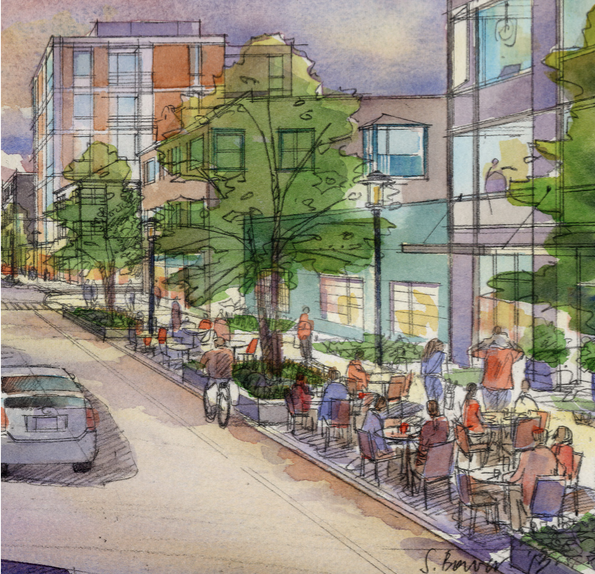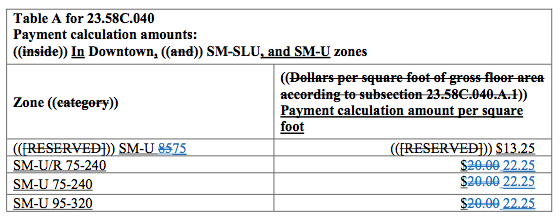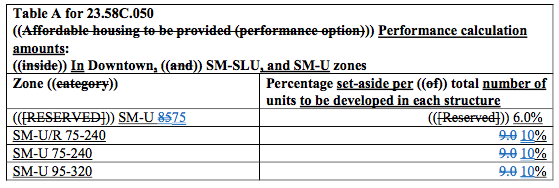A handful of amendments could find their way into the University District rezone and urban design proposal awaiting approval from the Seattle City Council. Next week (January 19th), the Planning, Land Use, and Zoning (PLUZ) Committee will meet to discuss the proposal and amendments. A final ordinance could be approved by the full City Council sometime in February.
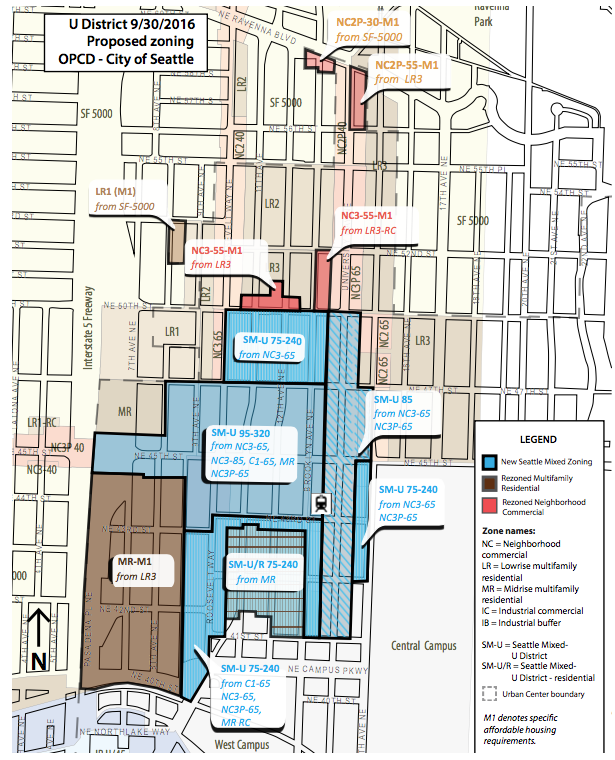
Before jumping into what amendments could be proposed, it’s worth recapping what is in the proposed University District rezone and urban design ordinance today. The proposal is a densely packed body of work that includes:
- Development capacity increases (rezones);
- Urban design considerations (e.g., height, bulk, scale, transparency, modulation, setbacks, stepbacks, and width);
- Incentives for historic preservation, open space, and vulnerable masonry structures;
- Other incentives for green building, childcare, transportation demand management, and human services; and
- Mandatory housing affordability requirements.
More than a dozen different amendments will be considered by the PLUZ Committee, which we’ll summarize in the following sections.
Amendments Related to The Ave
A suite of amendments related to The Ave could be adopted. These include changes to controls related to maximum building widths, height, and floor area allowances; eligibility for transfer of development rights; and preserving the pattern of small storefronts.
- Under the Mayor’s proposal, maximum building heights on The Ave are proposed to go to 85 feet using the neighborhood’s tailor-made Seattle Mixed-University District (SM-U) zoning type. But that could be slightly reduced to a maximum of 75 feet by a proposed amendment to create more pedestrian-scaled buildings on The Ave–a zoning change that would still allow 10 feet more in building height than under the current NC3(P)-65 zoning. The more measured SM-U 75 zoning change would retain the proposed maximum floor area. Under either zoning scenario, a maximum 6.0 FAR (floor area ratio) would be allowed. The Mayor’s SM-U 85 zoning proposal includes a 4.75 FAR base maximum in order to incentivize developers to buy their way through various options (e.g., open space, TDR, and green street improvements) to the full 6.0 FAR maximum, but no FAR base maximum would apply to properties zoned SM-U 75. Without the FAR incentive, developers will be less likely to provide some of the encouraged amenities unless outright FAR exemptions are provided. In tandem with this, certain language related to incentives would be amended to eliminate applicability to the SM-U 85 zone since it wouldn’t exist.
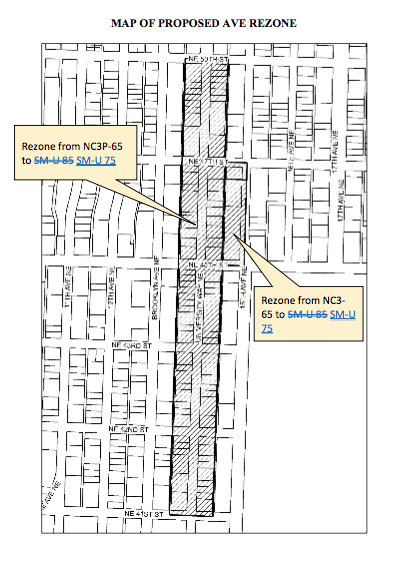
- Another amendment could alter the transfer of development rights (TDRs) program within the University District. Properties on The Ave with SM-U 75 zoning would only be able to send TDRs (for landmark, open space, and vulnerable masonry structures) to other SM-U zones in the district that are eligible to receive TDRs. Under the Mayor’s proposal, properties on The Ave would be zoned SM-U 85 and could qualify to both send and receive TDRs for the purpose of additional FAR beyond the base maximum. The amendment is consistent with the removal of any FAR base maximum allowance since there would be no incentive for SM-U 75-zoned properties to purchase (and receive) TDRs for additional development allowances. Adoption of the amendment would only make sense if the FAR and zoning change to The Ave, discussed above, is also adopted.
- Smaller building widths could be required for SM-U 75 zone. The Mayor’s proposal would establish a maximum building width of 250 feet for all SM-U zones, but an amendment specific to the SM-U 75 zone could further limit building widths to a maximum of 160 feet.
- To incentivize smaller commercial spaces along The Ave, an amendment may be proposed to exempt certain street-level, street-facing commercial spaces from counting toward a site’s FAR allowance. Individual commercial spaces would have to be 2,000 square feet or less in size to qualify for the exemption. Related amendments could be adopted in addition to or in lieu of the small storefront FAR exemption. These include policies to exempt maximum building width, as described above, if a certain percentage of a building frontage is dedicated to smaller retail spaces; require space for small street-level retail uses in buildings that front The Ave with the required number of units based on the total commercial floor area at the street level; and require an entrance to street-level retail spaces every 40 feet, with no unit size limit, to replicate the existing retail pattern. We previously provided some ideas to incentivize and mandate better retail districts, which may also be worth exploration by the PLUZ Committee.
Preserving the retail and commercial character of The Ave has been a significant issue throughout the University District Urban Design Framework. In recent months, the University District business community has been highly focused on this topic with an emphasis on commercial affordability. Many of the floated amendments above attempt to tackle the overarching issue of commercial district character and affordability head-on. But some aspects of the issue can’t be fully addressed through development regulations, which is why a separate resolution to supplement the land use ordinance could be adopted to memorialize the City’s intention to provide assistance in designing tenant spaces and business plan development, revise district design guidelines, provide financial assistance and 0% interest loans for small businesses, and develop other local tools, such as a tax abatement scheme and adjusted property taxes.
Modifications Related to Housing Affordability
Mandatory Housing Affordability (MHA) requirements could get a modest boost from the M1 type to the M2 type for the areas to be zoned for high-rise development. This would help deliver additional affordable housing units in area that has some characteristics for high risk of displacement as noted in the City’s Growth and Equity Analysis from Seattle 2035.
The MHA-Commercial fee in-lieu (payment) requirements would jump from $20.00 to $22.25 per square foot of commercial space while on-site set-aside (performance) requirements would jump from 9% to 10% of total square footage to be set-aside as affordable housing.
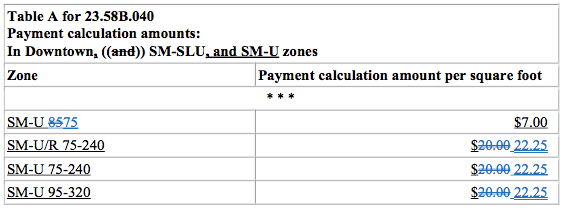
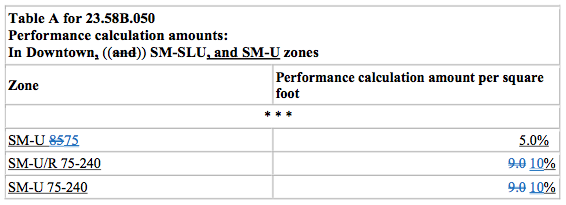

Meanwhile, the MHA-Residential fee in-lieu and on-site set-aside requirements would see similar jumps to that of MHA-Commercial:
If the amendment to zone The Ave to SM-U 75 is not adopted, the same requirements noted in the table that would otherwise apply to the SM-U 75 zone would be reverted to apply to the SM-U 85 zone. Or, the PLUZ Committee could consider even higher requirements in the spirit of the original MHA framework intent passed by the City Council this past summer which states:
The Council intends to consider whether to include higher performance and payment amounts, subject to statutory limits, for those areas where the increase in development capacity would be likely to increase displacement risk. Factors to consider are (a) areas that have been identified in Seattle 2035, Growth and Equity, Analyzing Impacts on Displacement and Opportunity Related to Seattle’s Growth Strategy, May 2016, as having a high displacement risk; (b) areas where the increment of increased development capacity is greater than the standard MHA-implementing zone change; and (c) areas where planning processes, including, but not limited to, the SEPA process for MHA-R implementation have identified affordable units at risk of demolition, the Council will consider whether to implement additional or alternate MHA program measures to increase affordable units sufficient to offset the affordable units at risk of demolition as a result of the increase in development capacity due to MHA.
The other MHA tables that will apply generally to other zones outside of Downtown, SM-SLU, and SM-U zones could be formally adopted to establish the requirements for M, M1, and M2 MHA rezones. These could include the following:
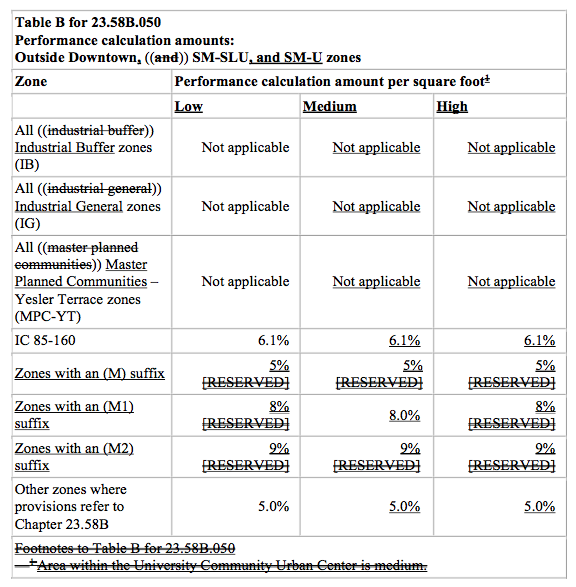
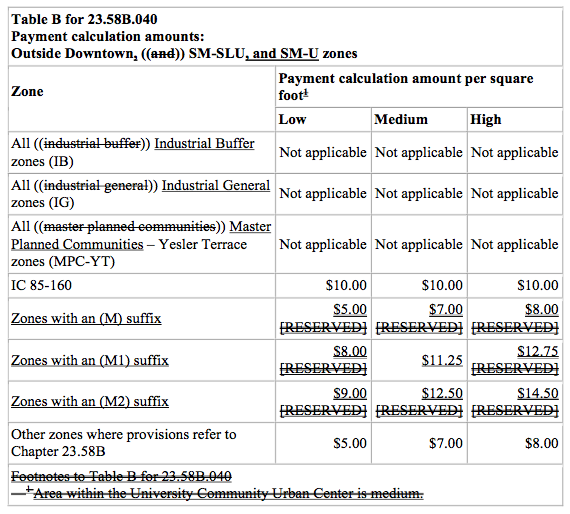
Additionally, an amendment related to family-sized units could be proposed to further encourage them in SM-U zones. The Mayor’s proposal provides up to an additional 0.5 FAR increment above the FAR base maximum if a development would provide at least 10 family-sized units with access to outdoor amenity space. But an alternative that the PLUZ may consider is to simply exempt floor area for family-sized units. It’s possible that the incentive could be so successful that it would result in development of family-sized units greater than the 0.5 FAR alternative.
Amendments Related to Zoning
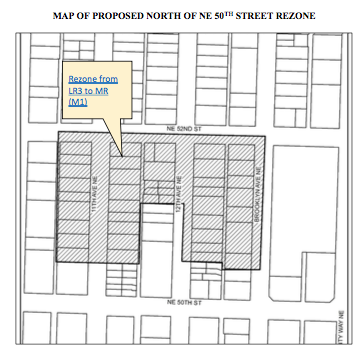
A pocket of LR3 zoning north of NE 50th St could be rezoned to MR (M1). Under the Mayor’s proposal, the parcels are not proposed to be rezoned, but had be considered earlier in the University District Urban Design Framework process. In fact, the draft rezone proposal released last May had specifically identified the parcels for MR zoning with 85-foot maximum heights. The Mayor’s proposal, however, would generally allow up to 80 feet in height with 4.5 FAR maximum. These same maximums would apply to this proposed rezone.
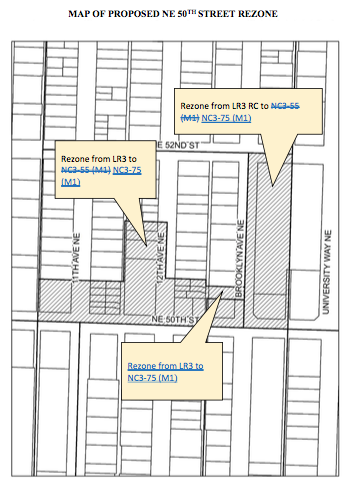
Another small pocket of parcels north of NE 50th St were dropped from the Mayor’s proposal for rezones while others saw reduced increases in development capacity over initial zoning proposal from last May. Across the board, the parcels north of NE 50th St would go from LR3 and LR3 RC to NC3-75 (M1) in the amended rezone. Under the Mayor’s proposal, most of the same parcels would only go to NC3-55 (M1). The floor area allowance between NC3-55 (M1) and NC3-75 (M1) is quite significant with a difference of 1.75 FAR. With a rezone to NC3-75 (M1), each development site could achieve a 5.5 FAR as opposed to a 3.75 FAR under NC3-55 (M1), and any NC3-75 (M1) site would have to achieve at least a 2.0 FAR minimum through new development. The increased zoning proposal is partially the result of requests by the YMCA and another property owner.
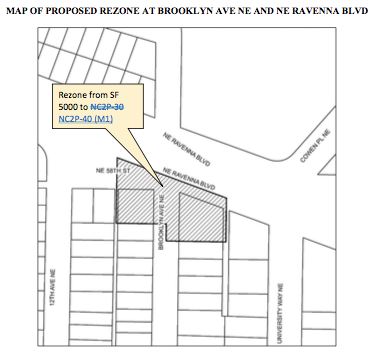
The Cowan Park Grocery site and an adjacent property are proposed to be rezoned from SF5000 to NC2P-30 (M1) under the Mayor’s proposal. But the property owner has requested greater flexibility for future development. Under a proposed amendment, the properties could go to NC2P-40 (M1) to allow both greater building height and floor area. The floor area ratio difference between NC2P-30 (M1) versus NC2P-40 (M1) is fairly consequential garnering an extra 0.5 FAR for NC2P-40 (M1) to total 3.0 FAR with any development required to achieve at least a minimum 1.5 FAR.
To put these proposed rezones amendments and other changes described above into an affordable housing perspective, the City has provided an estimate about how many more affordable housing units could be developed under higher MHA zoning and MHA requirements:
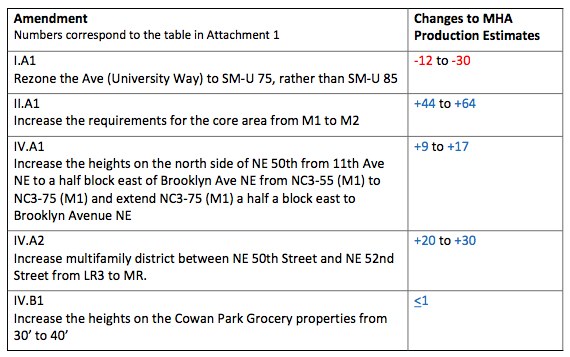
The biggest net increase would come from an outright change in MHA requirements applied to the proposed high-rise area of the University District, but the rezone of properties north NE 50th St to MR (M1) would have the second largest impact on long-term housing affordability.
Other Amendments
The PLUZ Committee will consider a host of other amendments, including the following:
- Language related to open space amenities that qualify for bonus floor area could clarify that such open spaces must be publicly accessible. In other words, a developer would not just be able to create an open space only accessible to their tenants; the open space would need to be available to everyone if it is to qualify for an FAR bonus.
- The University District TDR program could be expanded to include MR (M1) zones within the University Community Urban Center. The expansion would be limited allowing MR (M1) sites to become eligible as TDR sending properties if a landmark structure is located on-site. However, sites with open space and vulnerable masonry structures would not qualify for TDR, and no MR (M1) sites would be able to receive TDRs. Any TDRs derived from MR (M1) sites would have to be used on qualifying properties elsewhere within the University Community Urban Center. The result of the amendment would to be to further incentivize preservation of landmark-worthy buildings.
- Requirements for development of Transportation Management Program (TMP) Plans could be added to better manage developments that could have significant transportation impacts through single-occupant vehicle (SOV) trip generation. The types of developments that could be subject are any development that would generate 50 or more student or employee SOV trips during a given P.M. hour, or multi-family residential development that generates same number of SOV trips during a given P.M. hour or create a demand for 25 or vehicles to be parked on-street overnight. Such development proposals would have develop a compliant TMP Plan that meets the City’s adopted rules to reduce SOV trips within the University District. The Mayor’s proposal does touch on TMP Plan requirements, but the scope is much more limited in its applicability.
- Commercial floorplate allowances for high-rise development could be increased and provide greater flexibility for uses. Two options are being floated: one would provide greater flexibility for office high-rises generally and another would be targeted toward only greater flexibility for the University of Washington’s future high-rise above the light rail station. In the case of the light rail station high-rise, an average of 24,000 square floorplates would be allowed for the first 160 feet of the structure. In the alternative amendment scenario, conditions on higher floorplate allowances by use would be eliminated and instead the Mayor’s proposal would be modified as follow in Table A:

- Transparency requirements could be eliminated for light rail station uses. The Mayor’s proposal requires that at least 60% of street-level facades achieve transparency (except residential uses), but the University District light rail station’s design will not achieve that standard. Therefore, a proposed amendment will add an exemption for light rail station uses within the SM-U zoning district.
- A loading berth waiver could be added for SM-U zones to allow modifications from off-street loading requirements typically conditioned for certain uses and activities. The waiver would allow alternative means for loading.
In addition to the proposed amendments above, further technical amendments will be prepared to make non-substantive changes to the ordinance and providing housekeeping changes.
Next Steps
The PLUZ Committee will convene on January 19th to discuss these amendments and possibly more, but no vote on them or an amended ordinance will occur. A first vote on amendments will likely take place on February 7th with the land use ordinance possibly moving out of a committee. Final passage of a bill could happen mid-February at the soonest. In the meantime, those who have an interest in the proposal and amendments should contact Councilmember Rob Johnson, Chair of the PLUZ Committee, with any feedback.
City of Seattle – Central Staff Memo With Potential Amendments – 1-19-17 by The Urbanist on Scribd
Stephen is a professional urban planner in Puget Sound with a passion for sustainable, livable, and diverse cities. He is especially interested in how policies, regulations, and programs can promote positive outcomes for communities. With stints in great cities like Bellingham and Cork, Stephen currently lives in Seattle. He primarily covers land use and transportation issues and has been with The Urbanist since 2014.

